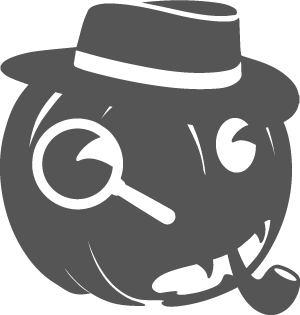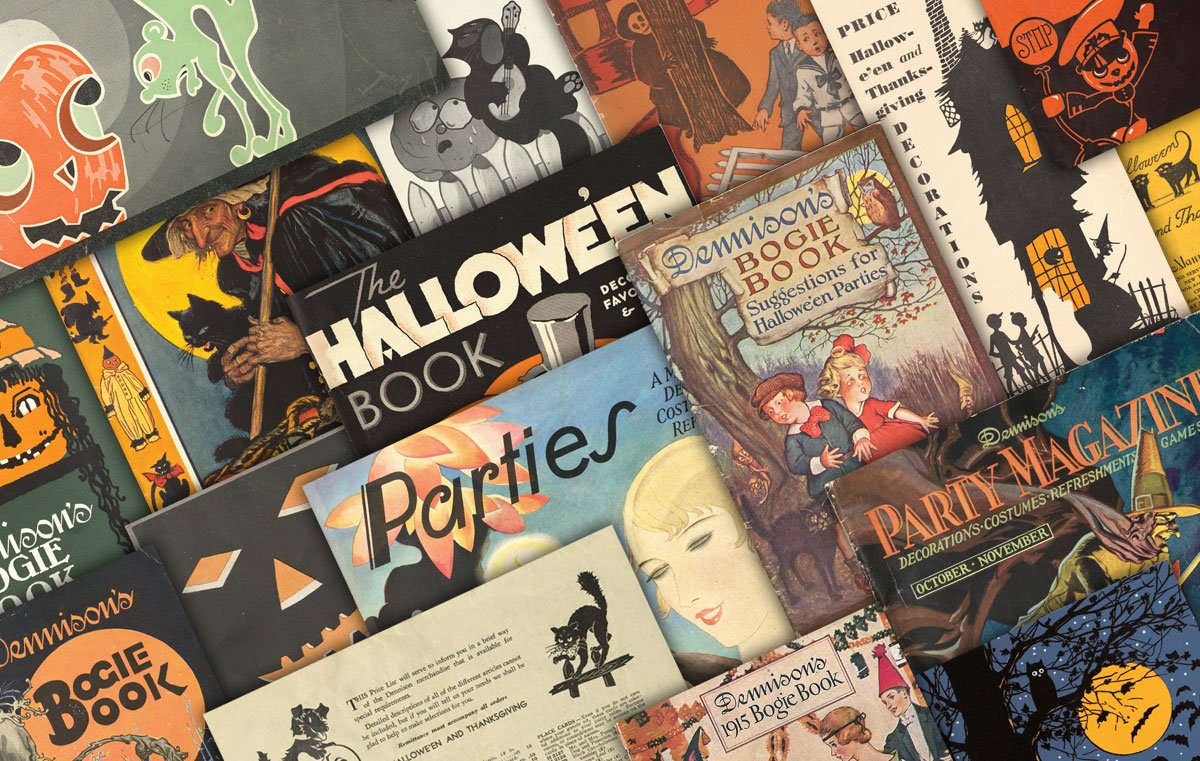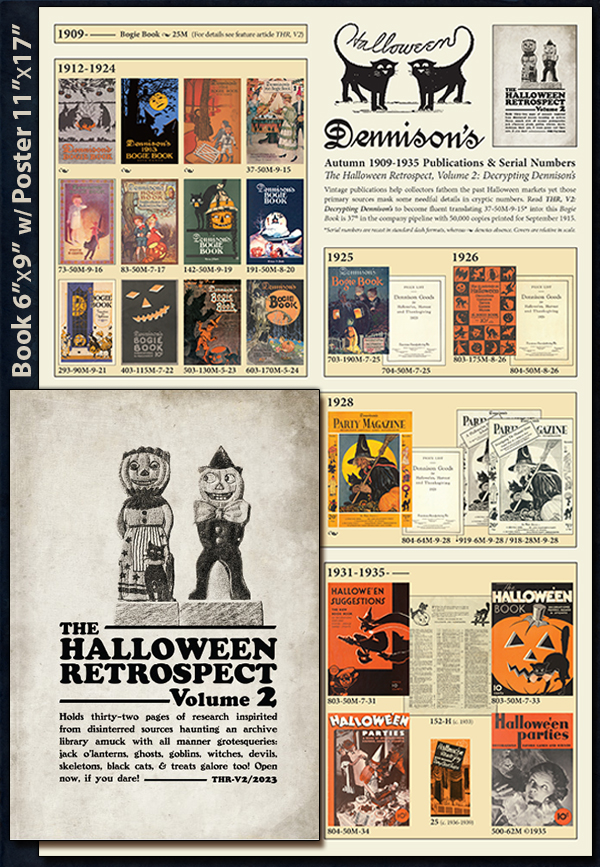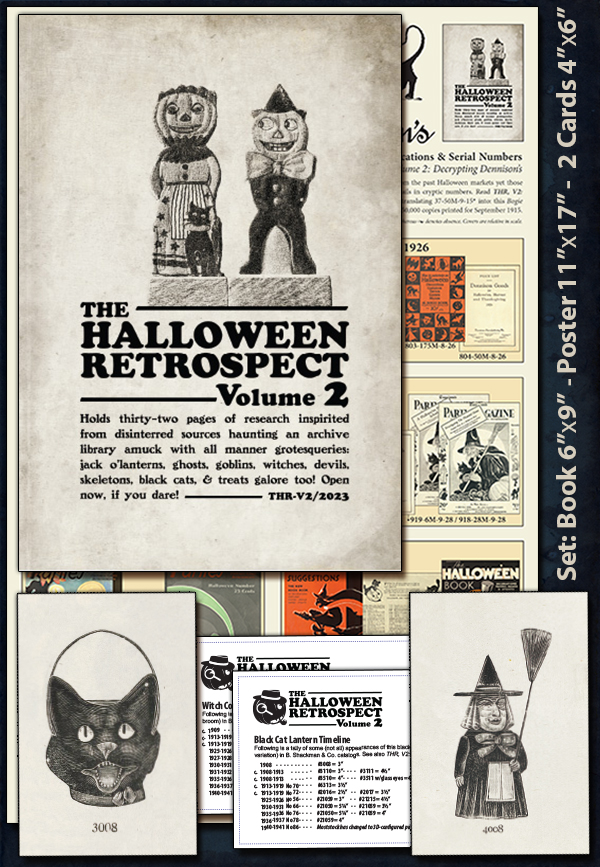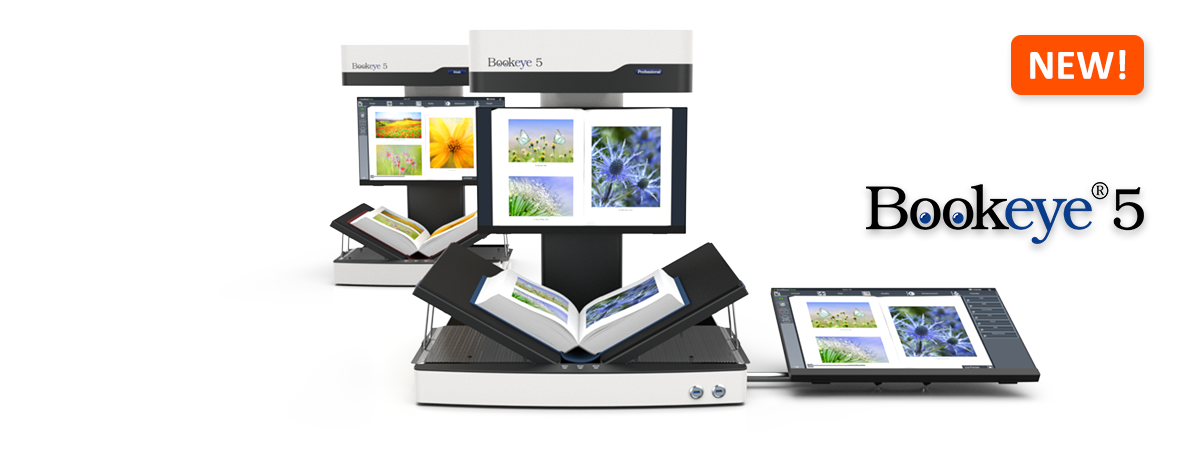A History in Numbers
Have you ever noticed a rather implausible code number stashed in the nooks and crannies of authentic vintage Dennison publications (such as Bogie Book, etc.)? Ever wonder if it holds any significance in terms of book collectibles? Now, in a feature article of The Halloween Retrospect, Volume 2, there is a comprehensive examination of such serial numbers as they appear on Dennison titles – like that sampled from the inside cover of the 1915 Bogie Book (below). The result of such a study allows readers to translate these important numbers into historical data, making this pivotal groundwork to all Dennison fans whether collector of vintage Halloween or general enthusiast of the company’s considerable output (holiday or otherwise).
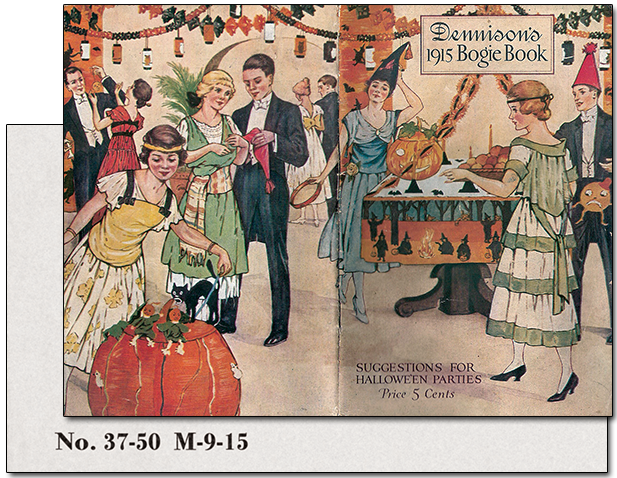
Dennison vintage Halloween titles, like the 1915 Bogie Book (above) are popular with book and holiday collectors, but how does one translate the serial number found on this and many other titles to understand the valuable information it contains?
“Decrypting Dennison: Serial Number Guide Featuring Autumn Publications” (THR, V2) is a purposefully conversational story as it reveals the numbering system’s solution. In this manner, readers may understand how the author arrives at the interpretation, and thus transfer this knowledge to their own Dennison collectibles (be that Christmas, Easter, Valentine’s Day, or even more general subjects). Therefore, the article offers a retelling of hours retrieving and recording ~200 titles into a spreadsheet, and of hours spent examining them for clues, while additional hours are spent pursuing verification documents from Framingham History Center (via essential help from Nancy Prince @dennisonarchivist).
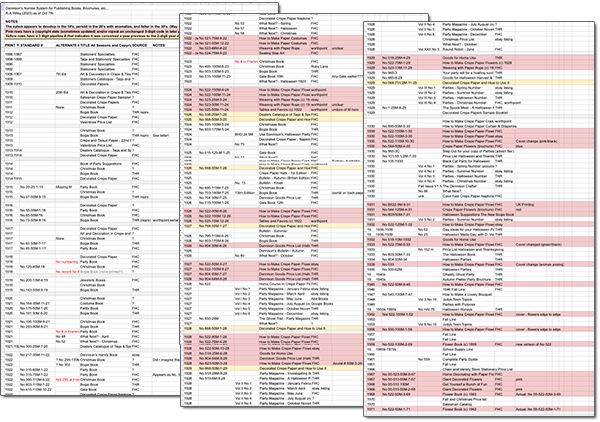
A spreadsheet of around 200 vintage titles by Dennison Manufacturing Company are entered into a spreadsheet (above). This uncovers what a small selection (such as Halloween) cannot, by allowing numbers, both standard and anomalous, to create the larger picture of Dennison publication history.
The 12-page article “Decrypting Dennison”THR, V2 not only deciphers serial numbers, the book includes an 11″x17″ fold-out poster. That poster is the first faithfully chronological list of Dennison’s Halloween publications (of book covers with serial numbers where available). Again, the results from the article allow the reader to use a reliable method of reading numbers on the poster, or directly from Dennison publications – be that a single instance of 1915 Party Book or How to Make Crepe Paper Flowers (published and republished for multiple decades).

The full-color 11″x17″ fold-out poster (above) of Dennison Halloween titles. The poster is included with official copies of The Halloween Retrospect, Volume 2 from THR’s etsy store.
Framingham History Center
The Framingham History Center (mentioned above) is located in Massachusetts with a mission (About Us, FHC), “to preserve and share Framingham’s history in order to encourage connection to community.” In recent history, these archives have been fortunate to receive a return of historic Dennison documents (from the company of previous merger, Avery). In turn that content has been organized by Nancy Prince (@dennisonarchivist) in a multi-year labor of love in memory of her parents, creating the discoverable and accessible archive we have today! And for more on how the archive came to be, see Framingham History Center To Unveil Dennison Manufacturing Company Exhibit (C. Frary, 11- 21-2014).
FHC’s windfall is a boon, not solely for the hometown of Dennison MFG Co., but communities at large. If you are engaged in modern research seeking Dennison history, there are now two locations from which to pursue, because the initial donation was that large. First, there is the Dennison Manufacturing Company Archives, 1844-1990: A Finding Aid to “document the history, financial performance, product development, marketing programs, publications and human resource management of the company.” But that is just 273 archival boxes; another 425 boxes subsequently went to Harvard Business School. So, second, there is the Dennison Manufacturing Company records collection. Together, that is a head spinning amount of Dennison info!
NOTE: please consider a donation or the purchase of a Membership to help support the Framingham History Center. I am sure most of us know the challenges all archives and libraries face to remain discoverable and accessible. If we, as collectors, can spend a bit of money on vintage objects, we can aid the institutions that further our knowledge. THR, though a hobbyist venture, has pledged to donate a portion of each sale from THR, V2 to Framingham History Center as a show of gratitude.
Decrypting Dennison, & More
To recap this blog entry, THR’s research (about Dennison and their serial numbers) fills the majority page count of THR, V2 to assure the reader receives meaningful information — and the conclusive contents could not have occurred without participation from Framingham History Center archives. This author feels the THR, V2 result is packed with relative data that readers can use in their own collecting activities. And, again, the book includes a full-color fold-out poster (of Dennison titles pulled from THR archive library) as an all-in-one survey of Dennison’s Halloween-themed printing, particularly the 1910’s, 1920’s, 1930’s. For a visual review of this content in The Halloween Retrospect, Volume 2 see the sample gallery below:
You may wish to note, as well as the article outlined above, the second article in THR, V2 discusses B. Shackman & Co. catalogs (and pertinent data), with a third article researching the German imports (seen on the cover), ending with a fourth article gazing at midcentury midseason catalogs by Sears and their availability of cards by E. Rosen Company.
Here is a link to more website info about The Halloween Retrospect, Volume 2 (a new research-based guide on the vintage market of Halloween collectibles) and here is a direct link to The Halloween Retrospect book sales – purchase a copy via Etsy checkout.
Bookeye Book Scanner
As an aside, it seems worth revisiting information from blog posting March’s Halloween Page that earlier discussed modern tools for creating a new poster. In this case (for Dennison), the separate publications are high-resolution imports using a Bookeye 5 book scanner by Image Access – a scanner that allows users to open printed material (naturally as suits the object) and scan from above – with output adjusted at times for variables including angle correction. In this way the a user is not damaging spine or pages as might occur when struggling with a flat-bed scanner.
If you are fortunate, some libraries and archives offer the use of these devices as did my local university. But for those more serious about an actual purchase, the Image Access site offers a list of distributors, and if you are in the Denver area the folks at Large Document Solutions have always been friendly and professional with inquiries about the device.
Second, (while noting that the Bookeye 5 has many image-fixing tools installed), THR also enjoys some of the post-production tools available in Adobe software including Photoshop, and these are utilized to get a few things flawlessly straight, correct color, slightly sharpen the resolution, as well as remove less desirable signs of age. And, ultimately, create the layout of the poster with the imported cover images.
The second half of this mastering process prepares the file for a printer who manages the final output, returned here to be one of the inserts with an official copy of THR-V2. This is a reason sales are done on an individual basis by the author via etsy – to include the poster (and the timeline cards), but also to examine the quality of each book set, shipped in a sturdy box.
Here is a link to more website info about The Halloween Retrospect, Volume 2 and a direct link to The Halloween Retrospect book sales – purchase a copy via Etsy checkout.
Follow THR on Instagram @halloweenretrospecs
Follow THR on Facebook Halloween Retrospect
